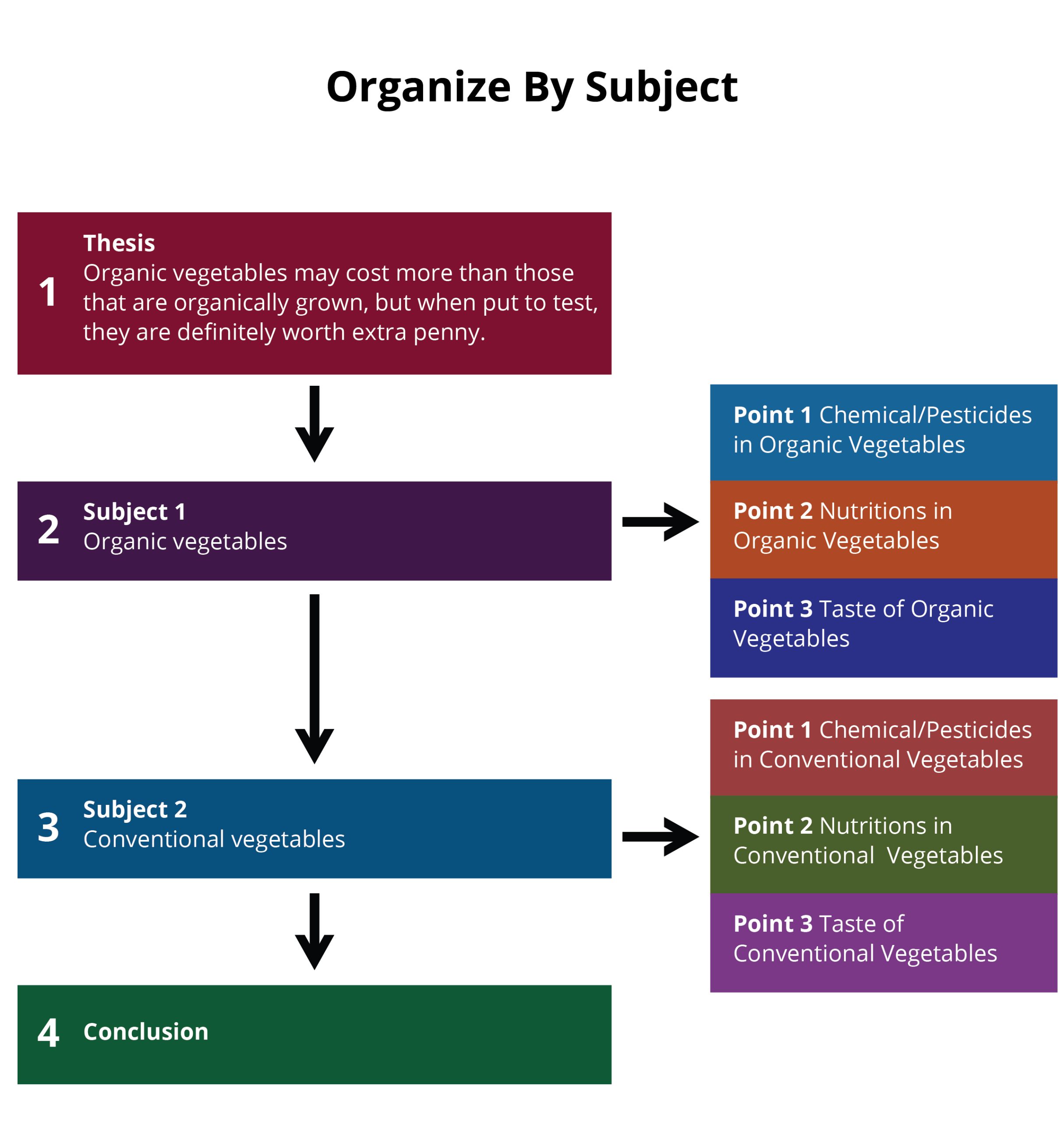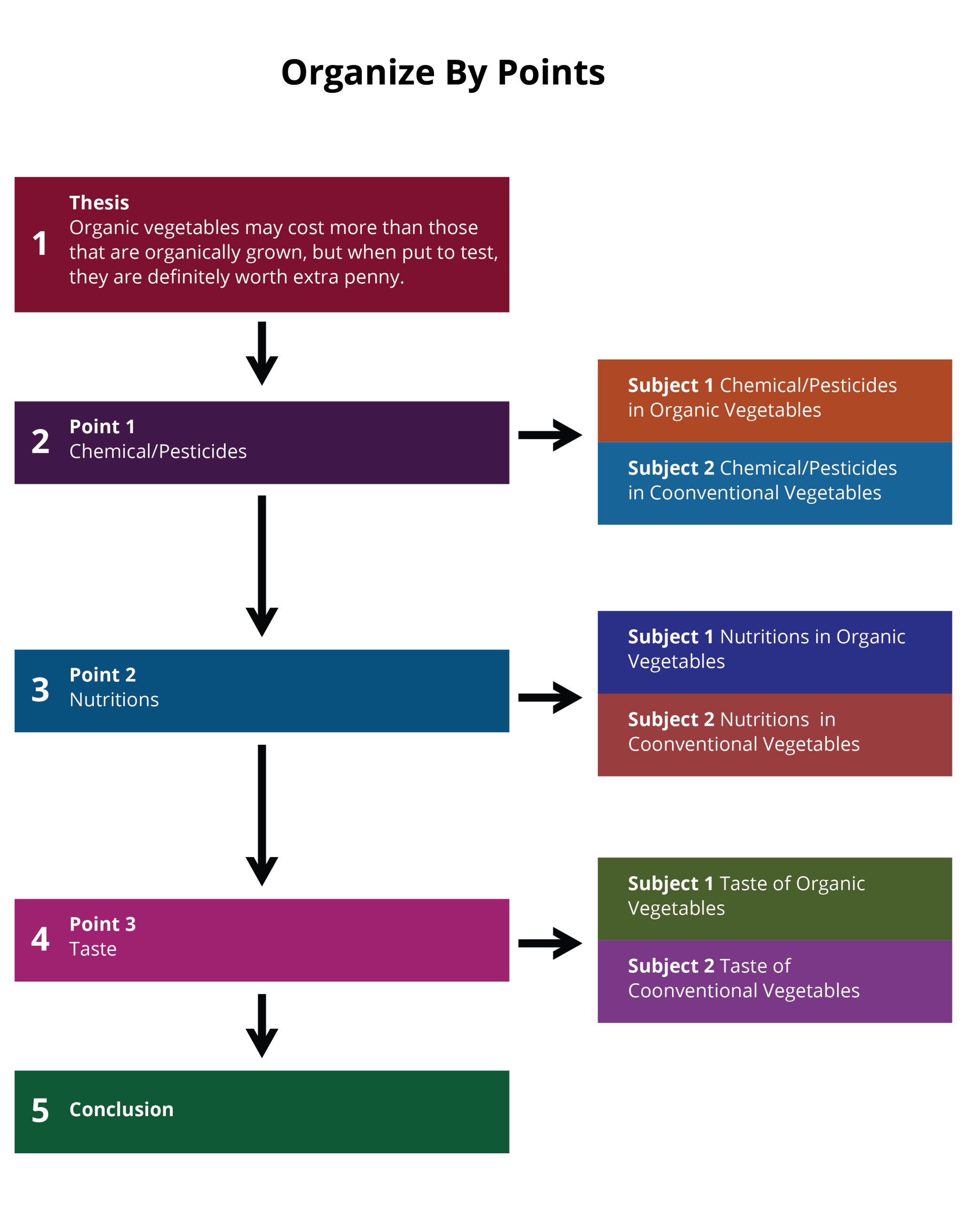5.1 – Comparison and Contrast
Learning Objectives
- Determine the purpose and structure of comparison and contrast in writing.
- Explain organizational methods used when comparing and contrasting.
- Understand how to write a compare-and-contrast essay.
The Purpose of Comparison and Contrast in Writing
Comparison in writing discusses elements that are similar, while contrast in writing discusses elements that are different. A compare-and-contrast essay , then, analyzes two subjects by comparing them, contrasting them, or both.
The key to a good compare-and-contrast essay is to choose two or more subjects that connect in a meaningful way. The purpose of conducting the comparison or contrast is not to state the obvious but rather to illuminate subtle differences or unexpected similarities. For example, if you wanted to focus on contrasting two subjects you would not pick apples and oranges; rather, you might choose to compare and contrast two types of oranges or two types of apples to highlight subtle differences. For example, Red Delicious apples are sweet, while Granny Smiths are tart and acidic. Drawing distinctions between elements in a similar category will increase the audience’s understanding of that category, which is the purpose of the compare-and-contrast essay.
Similarly, to focus on comparison, choose two subjects that seem at first to be unrelated. For a comparison essay, you likely would not choose two apples or two oranges because they share so many of the same properties already. Rather, you might try to compare how apples and oranges are quite similar. The more divergent the two subjects initially seem, the more interesting a comparison essay will be.
Writing at Work
Exercise 1
Brainstorm an essay that leans toward contrast. Choose one of the following three categories. Pick two examples from each. Then come up with one similarity and three differences between the examples.
- Romantic comedies
- Cell phones
- Social Media Platforms
Exercise 2
Brainstorm an essay that leans toward comparison. Choose one of the following three items. Then come up with one difference and three similarities.
- Online and In-store shopping
- Fast food chains and fine dining restaurants
- Dogs and cats
The Structure of a Comparison and Contrast Essay
The compare-and-contrast essay starts with a thesis that clearly states the two subjects that are to be compared, contrasted, or both and the reason for doing so. The thesis could lean more toward comparing, contrasting, or both. Remember, the point of comparing and contrasting is to provide useful knowledge to the reader. Take the following thesis as an example that leans more toward contrasting.
Here the thesis sets up the two subjects to be compared and contrasted (organic versus conventional vegetables), and it makes a claim about the results that might prove useful to the reader.
You may organize compare-and-contrast essays in one of the following two ways:
- According to the subjects themselves, discussing one then the other
- According to individual points, discussing each subject in relation to each point
See Figure 1 – “Comparison and Contrast Diagram”, which diagrams the ways to organize our organic versus conventional vegetables thesis.


Figure 1 – Text version
Organize by subject:
- Thesis (Organic vegetables may cost more than those that are conventionally grown, but when put to the test, they are definitely worth every extra penny).
- Subject 1: Organic Vegetables
- Chemicals/Pesticides
- Nutrition
- Taste
- Subject 2: Conventional Vegetables
- Chemicals/Pesticides
- Nutrition
- Taste
- Conclusion
Organize by Point:
- Thesis (Organic vegetables may cost more than those that are conventionally grown, but when put to the test, they are definitely worth every extra penny).
- Chemicals/Pesticides
- Organic
- Conventional
- Nutrition
- Organic
- Conventional
- Taste
- Organic
- Conventional
- Conclusion
The organizational structure you choose depends on the nature of the topic, your purpose, and your audience.
Given that compare-and-contrast essays analyze the relationship between two subjects, it is helpful to have some phrases on hand that will cue the reader to such analysis. See Table 1 “Phrases of Comparison and Contrast” for examples.
| Comparison | Contrast |
|---|---|
| one similarity | one difference |
| another similarity | another difference |
| both | conversely |
| like | in contrast |
| likewise | unlike |
| similarly | while |
| in a similar fashion | whereas |
Exercise 3
Writing a Comparison and Contrast Essay
First choose whether you want to compare seemingly disparate subjects, contrast seemingly similar subjects, or compare and contrast subjects. Once you have decided on a topic, introduce it with an engaging opening paragraph. Your thesis should come at the end of the introduction, and it should establish the subjects you will compare, contrast, or both as well as state what can be learned from doing so.
The body of the essay can be organized in one of two ways: by subject or by individual points. The organizing strategy that you choose will depend on, as always, your audience and your purpose. You may also consider your particular approach to the subjects as well as the nature of the subjects themselves; some subjects might better lend themselves to one structure or the other. Make sure to use comparison and contrast phrases to cue the reader to the ways in which you are analyzing the relationship between the subjects.
After you finish analyzing the subjects, write a conclusion that summarizes the main points of the essay and reinforces your thesis. Below, you can read a sample compare-and-contrast essay.
Sample compare-and-contrast essay
Read Print vs. eBooks in plain text/HTML
Note: HTML/plain text & Pressbooks do not always display page layout or APA formatting such as page numbers, spacing, margins or indentation accurately. Please review APA formatting rules to ensure you meet APA guidelines with your own work. The text version is included here in HTML format for ease of reading/use. You may also want to View Print vs. eBooks in PDF format.
Compare and Contrast: Print vs e-books
George-Anne Lerner
Reading print books and reading on screens are two different forms of reading that have unique advantages and disadvantages. While print books have been around for centuries and remain a popular choice for reading, digital reading on screens has become increasingly popular in recent years. Conventional print books offer the advantages of a tangible experience, convenience, and deeper learning, but e-books have large storage capacity and accessibility features; both versions carry a similar impact on the environment. Whether a reader chooses a Kindle, or an old-fashioned print book, there are many advantages to each option.
Traditional print books have several advantages, and are often the ones readers say they prefer, as they offer a tangible experience away from digital devices, deeper learning, and are convenient. Readers enjoy being able to hold physical copies of books, enjoying the feel of the texture of the pages.Several surveys show that print books are strongly preferred (Johnston & Salaz, 2019). When average screen time increased during the pandemic, many people saw print books as an opportunity to take a break from their digital devices (Wright, 2020). In addition to offering a rest from screens, print books boost reading comprehension. Several studies show that comprehension increases significantly for students who read printed materials compared to those who read digital texts (Mangen et al., 2013). Print is generally considered better for the learning and deep understanding of complex texts (Stoop et al., 2013). Also, print books are convenient, and they do not need to be plugged in or connected to the internet, making them a more accessible option for those who do not have access to these resources. Furthermore, print books are often viewed as more reliable and less prone to technical problems, such as malfunctions or lost data. Overall, traditional print books have many advantages and offer several benefits over their digital counterparts.
On the other hand, reading on screens offers several advantages that reading print books does not, including the ability to store multiple books, to adjust accessibility settings, and to navigate easily. Digital reading allows the reader to access and store a large number of books on a single device, which is useful for travel or in small homes. Additionally, e-books often allow the reader to customize the font size, background colour, and other reading settings, such as text to speech, making them easier to read for those with visual impairments or who struggle with reading. Studies show that E-books with audio functions assisted in language learning (Hsieh & Huang, 2020), and digital books with pictures also improved retention of information for learners (Wang & Chiu, 2020). Many findings show that electronic screens are best for quick information gathering, communication, and navigation (Stoop et al., 2013).While print may be preferred by those who want a physical book in their hands, e-books offer several advantages to readers.
The environmental impact of e-books and print books is a complex issue and ultimately, neither format offers a clear advantage. E-books may have a lower impact in terms of production than paper books (Tahara et al., 2018), but the disposal of electronic devices has to be taken into account. While production of print books has a direct environmental impact, they can be recycled and repurposed.Overall, the environmental impact depends on how often the e-book reader is used, and current studies challenge the bias that e-books offer a more environmentally sustainable experience than printed books (Kang et al,. 2021). Research indicates that the environmental impact of both printed and digital books seems to be about the same, showing no clear “winner” in environmental friendliness.
In conclusion, both print books and e-books have their own unique advantages and disadvantages. While print books offer a tangible and more immersive reading experience, digital reading is more convenient and can be more accessible. Neither one has been proven to be a superior option in terms of environmental impact. Ultimately, the best form of reading depends on individual preferences and the specific needs of the reader.
References
Hsieh, Y., & Huang, S. (2020). Using an E-book in the secondary English classroom: Effects on EFL reading and listening. Education and Information Technologies, 25(2), 1285-1301. http://doi.org/10.1007/s10639-019-10036-y
Johnston, N., & Salaz, A.M. (2019). Exploring the reasons why university students prefer print over digital texts: An Australian perspective. Journal of the Australian Library and Information Association, 68(2), 126-145. https://doi.org/10.1080/24750158.2019.1587858
Kang, Q., Lu, J., & Xu, J. (2021). Is e-reading environmentally more sustainable than conventional reading? Evidence from a systematic literature review. Library & Information Science Research, 43(3), 101105. https://doi.org/10.1016/j.lisr.2021.101105
Mangen, A., Walgermo, B. R., & Brønnick, K. (2013). Reading linear texts on paper versus computer screen: Effects on reading comprehension. International Journal of Educational Research, 58, 61–68. https://doi.org/10.1016/j.ijer.2012.12.002
Stoop, J., Kreutzer, P., & Kircz, J. G. (2013). Reading and learning from screens versus print: a study in changing habits: Part 2 – Comparing different text structures on paper and on screen. New Library World, 114(9), 371-383. https://doi.org/10.1108/NLW-04-2013-0034
Tahara, K., Shimizu, H., Nakazawa, K., Nakamura, H., & Yamagishi, K. (2018). Life-cycle greenhouse gas emissions of e-books vs. paper books: A Japanese case study. Journal of Cleaner Production, 189, 59–66. https://doi.org/10.1016/j.jclepro.2018.03.321
Wang H.-F., & Chiu, M.-C. (2020). Ebook presentation styles and their impact on the learning of children. Proceedings of the Interaction Design and Children Conference, 438–443. https://doi.org/10.1145/3392063.3394425
Wright, R. (2020, Oct 01). Will The Pandemic Be The Actual Death Of Print? Life Science Leader (Online).
Source: “Compare and Contrast: Print vs. eBooks” by Amanda Quibell is licensed under CC-BY-NC 4.0.
Exercise 4
Key Takeaways
- A compare-and-contrast essay analyzes two subjects by either comparing them, contrasting them, or both.
- The purpose of writing a comparison or contrast essay is not to state the obvious but rather to illuminate subtle differences or unexpected similarities between two subjects.
- The thesis should clearly state the subjects that are to be compared, contrasted, or both, and it should state what is to be learned from doing so.
- There are two main organizing strategies for compare-and-contrast essays.
- Organize by the subjects themselves, one then the other.
- Organize by individual points, in which you discuss each subject in relation to each point.
- Use phrases of comparison or phrases of contrast to signal to readers how exactly the two subjects are being analyzed.
Attribution & References
Except where otherwise noted, this chapter is adapted from ” 10.7 Comparison and Contrast” In Writing for Success by University of Minnesota licensed under CC BY-NC 4.0. / Adaptations were made to improve accessibility in this chapter. Essay sample was updated to a new topic with references & in-text citations.


